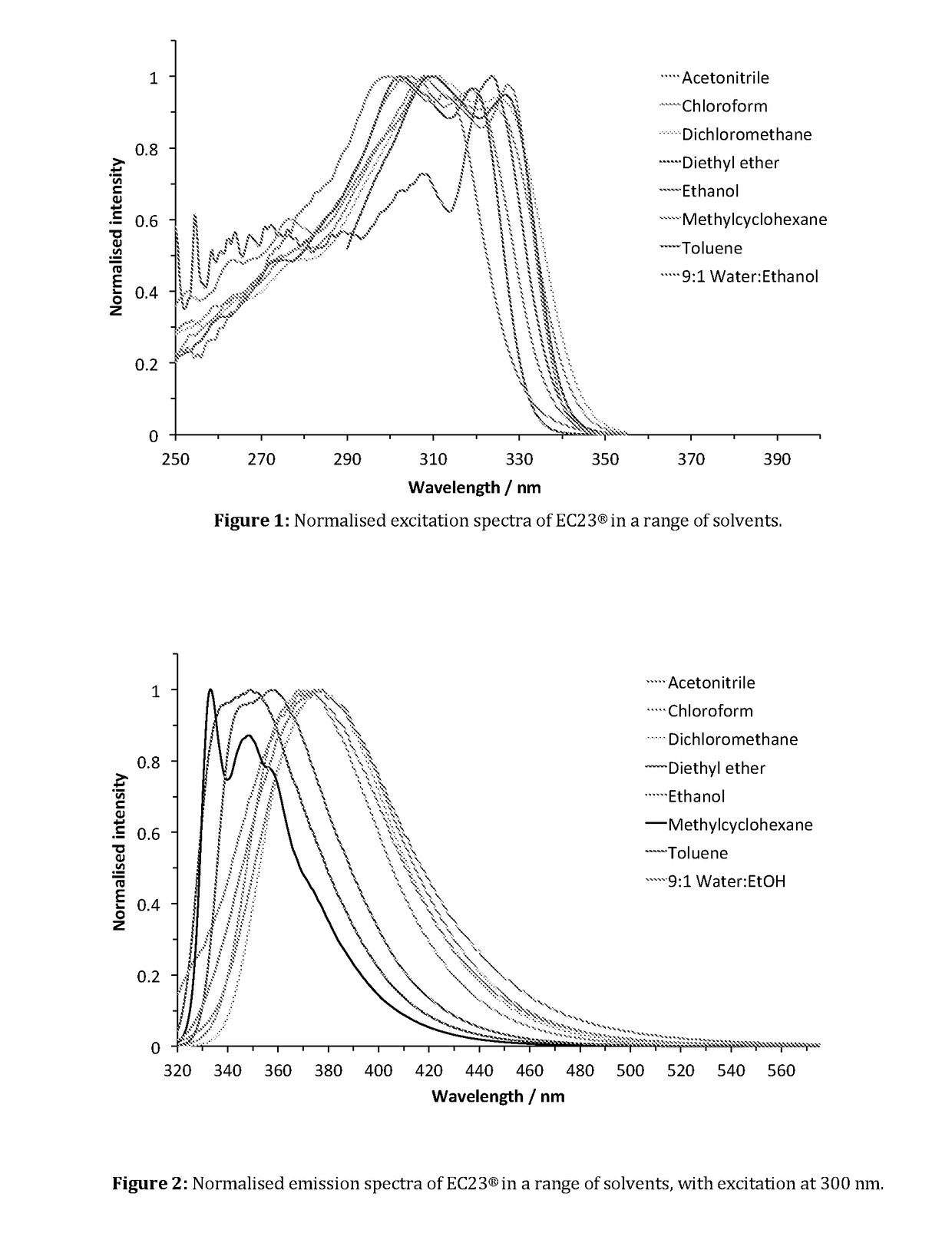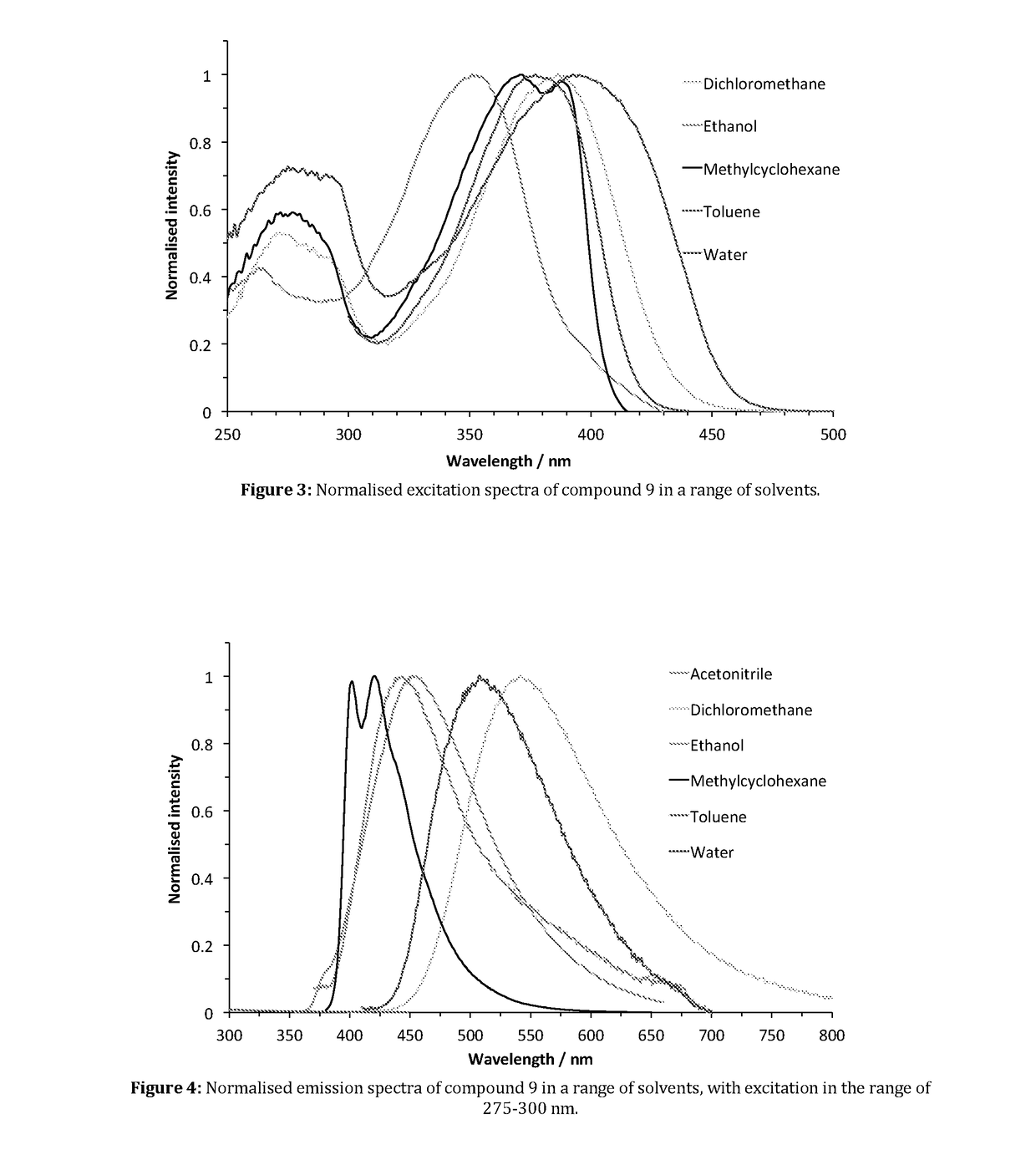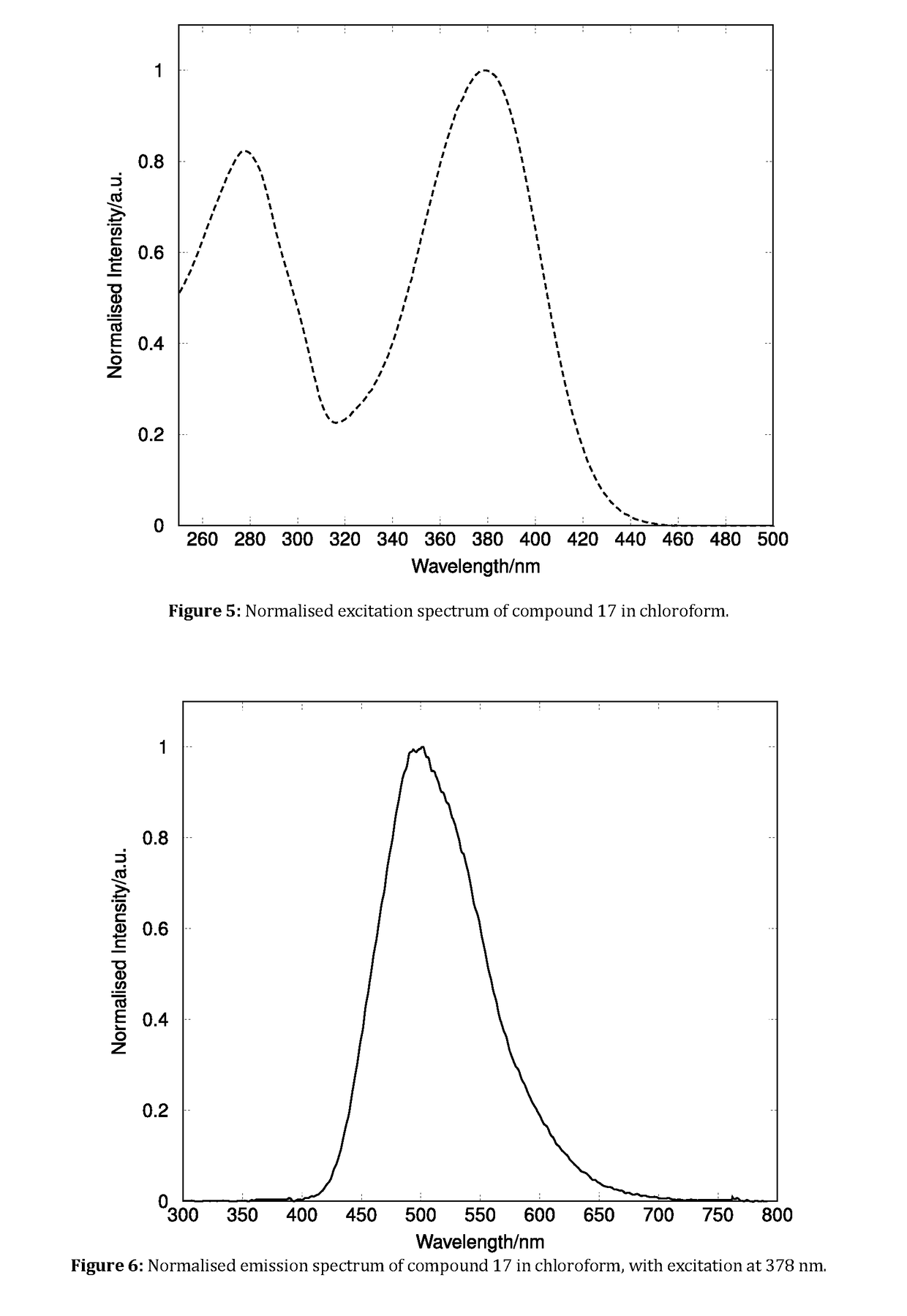Fluorescent Synthetic Retinoids
a technology of synthetic retinoids and fluorescence, which is applied in the field of new compounds, can solve the problems of increasing the cost associated with working with atra, reducing the yield of atra, and poor stability of atra, and achieves good yield effects
- Summary
- Abstract
- Description
- Claims
- Application Information
AI Technical Summary
Benefits of technology
Problems solved by technology
Method used
Image
Examples
example 2
Methyl 4-ethynylbenzoate (7)
[0156]
2(a) Methyl 4-iodobenzoate (5)
[0157]4-Iodobenzoic acid (25 g, 100.8 mmol) was suspended in MeOH (250 mL), and conc. H2SO4 (5 mL) was added and the resultant solution was stirred at reflux overnight. The clear solution was then cooled slowly to RT, and then to 0° C. The resultant solid was filtered, washed with cold MeOH and dried to give 5 as a colourless crystalline solid (23.7 g, 90%): 1H NMR (600 MHz, CDCl3) δ 3.90 (s, 3H), 7.73 (d, J=8.6 Hz, 2H), 7.79 (d, J=8.6 Hz, 2H); 13C NMR (176 MHz, CDCl3) δ 52.5, 100.9, 129.8, 131.2, 137.9, 166.7; IR (neat) νmax / cm−1 3040w, 2996w, 2946w, 1709s, 1596m, 1436m, 1269s, 1114s, 843s, 683m; MS (GC): m / z=261.9 [M]+. Found: C, 36.54; H, 2.71. Calc. for C8H7IO2: C, 36.67; H, 2.69%.
2(b) Methyl 4-((trimethylsilyl)ethynyl)benzoate (6)
[0158]An oven-dried 500 mL Schlenk flask was evacuated under reduced pressure and refilled with Ar, before Pd(PPh3)2Cl2 (1.18 g, 1.68 mmol), CuI (1.68 g, 1.68 mmol) and 5 (22.0 g, 83.98 mm...
example 3
4-2-[4,4-Dimethyl-1-(propan-2-yl)-1,2,3,4-tetrahydroquinolin-6-yl]ethynylbenzoic acid (9)
[0160]
3(a) 4-2-[4,4-Dimethyl-1-(propan-2-yl)-1,2,3,4-tetrahydroquinolin-6-yl]ethynylbenzoate, (8)
[0161]An oven-dried Schlenk flask was evacuated under reduced pressure and refilled with Ar, before Pd(PPh3)2Cl2 (0.0744 g, 0.106 mmol), CuI (0.0202 g, 0.106 mmol) and 7 (0.219 g, 1.37 mmol) were added and the flask sealed with a septum. A solution of 4 (0.349 g, 1.06 mmol) in triethylamine (6 mL) was added and the flask evacuated / filled with Ar again (3×). The mixture was stirred at RT for 72 h. The mixture was diluted with Et2O, passed through Celite / SiO2 under vacuum, and evaporated to give a crude orange solid (0.47 g). This was purified by SiO2 chromatography (hexane:EtOAc, 8:2, with 1% Et3N, as eluent) to give 8 as an orange solid (0.105 g, 27%): 1H NMR (700 MHz, CDCl3) δ 1.21 / 1.23 (s, 6H), 1.28 (s, 6H,), 1.66-1.71 (m, 2H), 3.19-3.24 (m, 2H), 3.92 (s, 3H), 4.15 (hept, J=6.6 Hz, 1H), 6.64 (d, J=...
example 4
3-[4-(1,4,4-Trimethyl-1,2,3,4-tetrahydroquinolin-6-yl)-phenyl]-acrylic acid methyl ester (13)
[0164]
4(a) Methyl-(3-methyl-but-2-enyl)-phenyl-amine
[0165]
In a 500 mL round bottomed flask a solution of N-methylanaline (3.24 g, 30.32 mmol), 1-bromo-3-methyl-but-2-ene (5.0 g, 33.56 mmol) and K2CO3 (4.63 g, 33.56 mmol) in 160 ml MeCN was heated at 85° C. for 18 h at which time analysis via in situ ES+-MS showed the reaction to be complete. The mixture was diluted with Et2O (100 mL) and washed with H2O (3×100 mL). The organic layer was dried with MgSO4, filtered and evaporated in vacuo to give a crude oil which was filtered through a silica pad, eluting with hexane. The solvent was removed in vacuo to give the title compound as a clear oil (3.82 g, 72%); m / z (ES+-MS) 176 (MH+); 1H NMR (499.76 MHz, CDCl3) δ 7.28 (2H, d, J=7.0 Hz), 6.79 (2H, d, J=7.0 Hz), 6.75 (1H, tr, J=7.0 Hz), 5.25 (1H, tr, J=6.0 Hz), 3.93 (2H d, J=6.0 Hz), 2.93 (3H, s) 1.76 (6H, s); 13C{1H} NMR (100.61 MHz, CDCl3) δ149.86...
PUM
 Login to View More
Login to View More Abstract
Description
Claims
Application Information
 Login to View More
Login to View More - R&D
- Intellectual Property
- Life Sciences
- Materials
- Tech Scout
- Unparalleled Data Quality
- Higher Quality Content
- 60% Fewer Hallucinations
Browse by: Latest US Patents, China's latest patents, Technical Efficacy Thesaurus, Application Domain, Technology Topic, Popular Technical Reports.
© 2025 PatSnap. All rights reserved.Legal|Privacy policy|Modern Slavery Act Transparency Statement|Sitemap|About US| Contact US: help@patsnap.com



